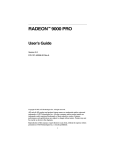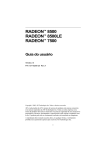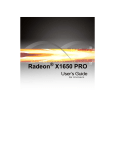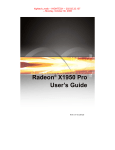Download ATI Technologies Radeon X600 User's Manual
Transcript
RADEON™ X600 User’s Guide P/N 137-40384-10 ATI ii Copyright © 2004, ATI Technologies Inc. All rights reserved. ATI and ATI product and product feature names are trademarks and/or registered trademarks of ATI Technologies Inc. All other company and/or product names are trademarks and/or registered trademarks of their respective owners. Features, performance and specifications are subject to change without notice. Product may not be exactly as shown in diagrams. Reproduction of this manual, or parts thereof, in any form, without the express written permission of ATI Technologies Inc. is strictly prohibited. Disclaimer While every precaution has been taken in the preparation of this document, ATI Technologies Inc. assumes no liability with respect to the operation or use of ATI hardware, software or other products and documentation described herein, for any act or omission of ATI concerning such products or this documentation, for any interruption of service, loss or interruption of business, loss of anticipatory profits, or for punitive, incidental or consequential damages in connection with the furnishing, performance, or use of the ATI hardware, software, or other products and documentation provided herein. ATI Technologies Inc. reserves the right to make changes without further notice to a product or system described herein to improve reliability, function or design. With respect to ATI products which this document relates, ATI disclaims all express or implied warranties regarding such products, including but not limited to, the implied warranties of merchantability, fitness for a particular purpose, and noninfringement. Product Notices Dolby* Laboratories, Inc. Manufactured under license from Dolby Laboratories. Confidential Unpublished Works. © 1992-1997 Dolby Laboratories, Inc. All rights reserved. Macrovision Apparatus Claims of U.S. Patent Nos. 4,631,603, 4,577,216, 4,819,098, and 4,907,093 licensed for limited viewing uses only. This product incorporates copyright protection technology that is protected by method claims of certain U.S. patents and other intellectual property rights owned by Macrovision Corporation and other rights owners. Use of this copyright protection technology must be authorized by Macrovision Corporation, and is intended for home and other limited viewing uses only unless otherwise authorized by Macrovision Corporation. Reverse engineering or disassembly is prohibited. Documentation Updates ATI is constantly improving its product and associated documentation. To maximize the value of your ATI product, you should ensure that you have the latest documentation. ATI’s documentation contains helpful installation/configuration tips and other valuable feature information. iii L IMPORTANT SAFETY INSTRUCTIONS • Read Instructions - All the safety and operating instructions should be read before the product is operated. • Retain Instructions - The safety and operating instructions should be retained for future reference. • Heed Warnings - All warnings on the product and the operating instructions should be adhered to. • Compatibility - This option card is for use only with IBM AT or compatible UL Listed personal computers that have Installation Instructions detailing user installation of card cage accessories. • Grounding - For continued protection against risk of electric shock and fire, this accessory should be installed only in products equipped with a three-wire grounding plug, a plug having a third (grounding) pin. This plug will only fit into a grounding-type power outlet. This is a safety feature. If you are unable to insert the plug into the outlet, contact your electrician to replace the obsolete outlet. Do not defeat the safety purpose of the grounding-type plug. • Secure Attachment - All card securement pins shall be completely tightened as to provide continuous bonding between the option card and the PC chassis. • Outdoor Antenna Grounding - Since an outdoor antenna or cable system is connected to the product, be sure that the antenna or cable system is grounded so as to provide some protection against voltage surges and built-up static charges. Article 810 of the National Electrical Code, ANSI/NFPA 70, provides information with regard to proper grounding of the mast and supporting structure, grounding of the lead-in wire to the antenna discharge unit, size of grounding conductors, location of antenna-discharge unit, connection of grounding electrodes, and requirements for the grounding electrode. • Lightning - For added protection for this product during a lightning storm, or when it is left unattended and unused for long periods of time, unplug it from the wall outlet, and disconnect the antenna or cable system. This will prevent damage to the product due to lightning and power-line surges. • Power Lines - An outside antenna system should not be located in the vicinity of overhead power lines or other light or power circuits, or where it can fall into such power lines or circuits. • Antenna Installation - When installing an outside antenna system, extreme care should be taken to keep from touching such power lines or circuits, as contact with them may be fatal. • Note to CATV System Installer - This reminder is provided to call the CATV systems installer’s attention to Section 820-40 of the NEC, which provides guidelines for proper grounding and, in particular, specifies that the cable ground shall be connected to the grounding system of the building, as close to the point of cable entry as practical. iv v Table of Contents Introduction . . . . . . . . . . . . . . . . . . . . . . . . . . . . . . . 1 RADEON™ X600 Features Graphic Features External Connections 1 1 1 Using Multiple Displays . . . . . . . . . . . . . . . . . . . . . 3 Connecting Your Monitors Display Configurations 3 5 ATI’s CATALYST™ Software Suite . . . . . . . . . . . . 7 Introduction Features Multiple Displays and 3D Gaming HYDRAVISION™ Accessing the CATALYST™ Software Suite ATI Displays Tab ATI Color Tab Hotkeys Color Hotkeys Settings ATI Options Tab Options Details Tab ATI Rotation Tab Rotation HotKeys ATI Overlay Tab Video Overlay Clone Mode Settings ATI 3D Tab Custom Properties Dialog Direct 3D® Compatibility Settings OpenGL® Compatibility Settings ATI VPU Recover Tab 7 7 7 7 7 8 10 14 15 17 18 19 21 22 22 23 25 27 30 31 32 Using TV Display and Capture Features . . . . . . . 35 Using TV Out View your PC’s display on a TV Starting Windows® with TV Display Enabled Using SCART Connectors for European TVs How To Enable/Disable The TV Display 35 35 36 37 38 vi Using and Adjusting TV Display Features 38 How TV Display Cannot Be Used 38 Using a Monitor vs. Using TV Display 38 Adjusting Monitor Display 38 Viewing Text on a TV 39 Reducing Edge Distortion 39 Using TV Display Alone 40 Using Games and Applications 40 Select your TV broadcast format 40 Adjust your TV screen size 41 Adjust your TV screen position 42 Adjust the composite sharpness of your TV display 42 Adjust the S-Video sharpness of your TV display 43 Adjust the composite dot crawl on your TV Display 43 Adjust the chroma flicker removal setting on your TV Display (if available) 44 Adjust the luma flicker removal setting on your TV Display 44 Reset the advanced settings on your TV Display(if available) 45 Connect to a TV, VCR, or Camcorder for video capturing 46 Windows® Volume Control 46 Capturing video using Windows® Movie Maker 47 Compliance Information . . . . . . . . . . . . . . . . . . . . 49 FCC Compliance Information Industry Canada Compliance Statement CE Compliance Information L’Information de conformité de la CE CE-befolgungInformationen 49 49 50 50 50 Index . . . . . . . . . . . . . . . . . . . . . . . . . . . . . . . . . . . . 51 RADEON™ X600 Features 1 CHAPTER 1: Introduction RADEON™ X600 Features Graphic Features • Four parallel rendering pipelines. • SMARTSHADER™ 2.1 • Full hardware-based support for Microsoft® DirectX® 9.0/9.1 programmable vertex and pixel shaders in hardware. • Shadow volume rendering acceleration. • Complete feature-set support for OpenGL® 1.5 and 2.0 extensions. • SMOOTHVISION™ 2.1 • Full-scene anti-aliasing method that smooths uneven edges and improves blurred images. • 2x/4x/6x Anti-aliasing modes with aloss-less compression up to a ratio of 6:1 at all resolutions. • 2x/4x//8x/16x Anisotropic Filtering modes with up to 128-tap texture filtering. • HYPER Z™ III • Ensures optimal hardware performance by discarding irrelevant object data that is not visible to the user. • Conserves video memory bandwidth. • Loss-less Z-buffer compression • Z Cache optimized for real-time shadow rendering. • VIDEOSHADER™ • Seamlessly integrates pixel shaders with video in real time. • All format DTV/HDTV decoding. • Adaptive Per-Pixel- De-interlacing and Frame Rate Conversion. External Connections • 15-pin D-shell (female) VGA output. • DVI-I output. 2 RADEON™ X600 Features • S-Video output or Video In/Video Out (VIVO) connection. 3 CHAPTER 2: Using Multiple Displays [Following content object needs to be changed (or added to) since the DVII-VGA adapter is presumably not included - KSR] Connecting Your Monitors Your RADEON™ X600 provides hardware support for one DVI-I monitor or two VGA monitors using the supplied DVI-I-to-VGA adapter. It also provides TV output via a S-Video Out or Composite Out connector. Connections and Adapters for the RADEON™ X600 Card X Standard VGA Monitor Connector. To connect a VGA monitor to the DVI-I connector, plug the supplied DVI-I-to-VGA adapter into the DVI-I connector, then plug your monitor cable into the adapter. 4 Connections and Adapters for the RADEON™ X600 Card Y DVI-I-to-VGA Adapter. Z DVI-I Backplate Connection. To connect a flat panel, plug the monitors DVI-I connector into the DVI-I connection. Note: If you use multiple monitors, the RADEON™ X600 card must be the primary graphics card. Normally, the system BIOS determines which graphics card will be the primary. X DVI-I Backplate Connection. To connect a flat panel, plug the monitors DVI-I connector into the DVI-I connection. Y DVI-I Backplate Connection. To connect a flat panel, plug the monitors DVI-I connector into the DVI-I connection. To connect your monitors 1 Power off your computer and monitors. 2 Plug the monitor cables into their appropriate connectors. Display Configurations 5 3 Power on your monitors first, and then restart your computer so that Windows® can detect the new hardware settings. 4 When the New Hardware Found Wizard appears, at the appropriate prompt insert the ATI Installation CD to load the drivers for your RADEON™ X600 card. To set up a multi-monitor display (optional) 1 From the Start menu click Control Panel, then Display. Click the Settings tab to access the basic multi-monitor configuration settings. Note: ATI software provides many additional configuration features that can be accessed by clicking the Advanced button from the Display Properties > Settings tab. 2 Select the Monitor icon identified by the number 2. 3 Click Extend my Windows desktop onto this monitor. 4 Set the Screen Resolution and Color Quality as appropriate for the second monitor. Click Apply or OK to apply these new values. • Refer to your Windows online help and documentation for further information on using the Settings tab. Note: When you use multiple monitors with your card, one monitor will always be Primary. Any additional monitors will be designated as Secondary. Display Configurations Your RADEON™ X600 graphics card provides dual display functionality and TV Out. The following table lists the different ways you can connect displays to your card. Display Configuration Connector(s) Used Comments Single CRT display VGA connector OR DVI-I connector with DVI-I-to-VGA adapter CRT- cathode ray tube analog display. Single DFP display DVI-I connector DFP - digital flat panel display. 6 Display Configurations Display Configuration Connector(s) Used Comments Single TV S-Video Out The S-Video out can also support a composite connection via the SVideo-to-Composite adapter. CRT display + TV VGA connector + S-Video Out UNSUPPORTED CONFIGURATION if the CRT display is attached to the DVI-I connector via the DVI-I-to-VGA adapter. DFP display + TV DVI-I connector + S-Video out CRT display + DFP display VGA connector + DVI-I connector CRT display + CRT display VGA connector + DVI-I connector with DVI-I-to-VGA adapter The DVI-I connector can support a CRT display using the DVI-I-to-VGA adapter CRT display + DFP display + TV VGA connector + DVI-I connector + S-Video Out The TV display will “clone” the image of one of the other two displays CRT display + CRT display + TV VGA connector + DVI-I connector with DVI-I-to-VGA adapter + S-Video Out UNSUPPORTED CONFIGURATION Introduction 7 CHAPTER 3: ATI’s CATALYST™ Software Suite Introduction This chapter describes using the advanced multiple-monitor and 3D graphics features in ATI’s CATALYST™ Software Suite. Features Multiple Displays and 3D Gaming ATI’s CATALYST™ Software Suite provides multiple-display functionality, and its advanced graphic features, such as SMARTSHADER™ HD, provide the ultimate 3D gaming experience. The CATALYST™ Software Suite also supports the latest versions of Direct 3D® and OpenGL®. Many 3D game titles will virtually come to life through the advanced Direct 3D® or OpenGL® features. Gamers can finetune these settings for the ultimate experience in 3D image quality or 3D gaming performance. HYDRAVISION™ In addition to the multiple display functionality available with ATI’s CATALYST™ Software Suite, you can also use HYDRAVISION™ for advanced multi-monitor management. For more information on HYDRAVISION™ , please refer to the HYDRAVISION™ User’s Guide PDF located on your ATI Installation CD. Accessing the CATALYST™ Software Suite For help installing the CATALYST™ Software Suite, refer to the Getting Started Guide. The CATALYST™ Software Suite installs the ATI display tabs into the Windows® Display Properties dialog. They are accessed through the Advanced button located on the Settings tab. 8 ATI Displays Tab To access the Display Properties dialog, right-click on the desktop or navigate through Windows® Control Panel, which is located in the Start menu. Windows® Display Properties Settings Tab ATI Displays Tab The ATI Displays tab provides control over multiple-monitor features. Here you can enable/disable display devices and swap the assignment of Primary and Secondary displays. ATI Displays Tab 9 ATI Displays Tab ATI Displays Tab Scheme Displays the drop-down list of available display-device configurations that have previously been created. New configurations can be entered here and then saved using the Save button. Hotkey Associates a hotkey with a scheme. To input the hotkey, highlight the field and press the appropriate key combination on your keyboard. Save button Saves display-device configuration schemes. Delete button Deletes display-device configuration schemes. Display buttons Enables or disables a display device; they also indicate whether a device is enabled or disabled. Troubleshoot button Opens a Troubleshoot dialog to assist with possible display problems. 10 ATI Color Tab To enable or disable a display If the enable/disable button is green, it indicates the device is enabled. If it is red, it indicates the device is disabled. If the button is greyed out, the device is not an option. For example, if there is only one monitor connected, all buttons will be grey. 1 Click the enable/disable button want to enable/disable. 2 Click OK or Apply to save the changes. for the display device you Note: Due to power restrictions, you can normally only have two devices active at the same time; for example, two monitors or a monitor and a TV. To save a display-device scheme Display-device selections can be saved as a scheme for quick recall. 1 Click the enable/disable button want to have active. 2 Type a name into the Scheme drop-down list field. 3 Click Save to save the scheme. for the display devices you ATI Color Tab The ATI Color tab allows you to configure Gamma, Brightness, and Contrast color settings for both your desktop and full screen 3D environments. You can also save settings to a color profile for easy recall. In addition, you can assign unique hotkey combinations that allow you to adjust Gamma, Brightness, and Contrast color settings within your full screen 3D applications. ATI Color Tab 11 ATI Color Tab: Desktop Settings 12 ATI Color Tab ATI Color Tab: Full Screen 3D Settings ATI Color Tab Desktop radio button Select Desktop to configure your desktop color settings. Full Screen 3D radio button Select Full Screen 3D to configure the color settings for your 3D application. Note that the configured settings will only be apparent within a full screen 3D application environment. Profiles for Indicates whether the profiles in the drop-down list are for your Desktop or a Full Screen 3D environment. Profiles dropdown list Lists all of the Desktop or Full Screen 3D profiles that you have saved. Selecting a profile from the list loads those custom color settings for the relevant environment. To create a new profile, simply type in a name and click Save. ATI Color Tab 13 ATI Color Tab Save button Saves your current color settings to a Desktop or Full Screen 3D profile, using the name you specified in the list box. To restore these settings later, simply select the Profile name from the list and click Apply or OK. Delete button Deletes the profile that is selected in the Profiles list box. All Colors checkbox Adjusts the Gamma, Brightness or Contrast for Red, Green, and Blue simultaneously. Note that any individual color settings in effect are lost if All Colors is selected; the color settings revert back to the last-known All Colors settings. Red, Green, and Blue radio buttons Selects the active color component (Red, Green, or Blue) whose values will be adjusted by the Gamma, Brightness, and Contrast sliders. Note that any individual color settings made are lost if you subsequently select All Colors. Gamma slider Increases or decreases the gamma correction of your Desktop or full screen 3D application. Changing the gamma alters the curvature of the color curve. Brightness slider Increases or decreases the color brightness of your Desktop or full screen 3D application. Changing the brightness adjusts the vertical position of the color curve. Contrast slide Increases or decreases the color contrast of your Desktop or full screen 3D application. Changing the contrast adjusts the slope of the color curve. Reset buttons Restores an individual slider setting to its default value. Click Apply or OK to save. Color preview box The color image indicates visually how the Gamma, Brightness and Contrast sliders affect the final color settings of your display device. In Desktop mode, clicking on this with your mouse pointer will change the image. Hotkeys button Opens the Color Hotkeys Settings dialog. There you can assign hotkeys for adjusting your color settings within a full screen 3D application environment. To activate this button, you must select the Full Screen 3D radio button. Defaults button Restores all of the color settings to the default values. Click Apply or OK to save. To create a Desktop or Full Screen 3D profile 1 Choose either the Desktop or Full Screen 3D radio button, as desired. 14 ATI Color Tab 2 Adjust the Gamma, Brightness, and Contrast sliders to the desired settings, either individually or using the All Colors checkbox. 3 Type a profile name in the Profile list box. 4 Click Save. To apply the settings for a specific Desktop profile 1 Choose the Desktop radio button. 2 Select the profile name from the drop-down list box. 3 Click Apply or OK. To apply the settings for a Full Screen 3D profile 1 Choose the Full Screen 3D radio button. 2 Select the profile name from the drop-down list box. 3 Click Apply or OK. 4 Start your 3D application in full-screen mode. Hotkeys Some 3D applications automatically load their own color settings rather than those set through the ATI Color tab. To use custom settings, you can preconfigure hotkey combinations to either adjust the individual color properties or apply profiles you have created, once the 3D application is running. To access the Color Hotkeys Settings dialog 1 Select the Full Screen 3D radio button. 2 Click the Hotkeys button to access the Color Hotkeys Settings dialog. The easiest way to apply your own color settings from within a full screen 3D application is to create a Full Screen 3D profile and save it, assign hotkeys for the “Load Current Profile” action through the Hotkeys dialog, make sure that the profile you prefer is selected from the drop-down list box, and click OK. Once inside the 3D application, use the hotkeys to trigger the profile. ATI Color Tab 15 Some 3D applications allow you to switch easily between full-screen mode and windowed mode, and do not load their own color settings. In windowed mode, you can make slider adjustments or select a different profile on the Color tab, then switch back to full-screen mode to see the effects immediately. Color Hotkeys Settings Some full screen 3D applications automatically load their own color settings rather than those set through the ATI Color tab. If you want to force the application to use your custom settings, you can preconfigure hotkey combinations to either adjust the individual color properties or apply profiles you have created from within the 3D application. This control is accomplished through the Color Hotkeys Settings dialog of the Color properties tab. Color Hotkeys Settings Dialog Color Hotkey Settings Modifier key In combination with the Hotkey, specifies the hotkey combination that triggers an action. The Modifier key can be any combination of Alt, Ctrl, or Shift. Note that the Shift key is never used alone. 16 ATI Color Tab Color Hotkey Settings Hotkey In combination with the Modifier key, specifies the hotkey combination that triggers an action. Hotkey can be any key listed. To avoid conflicts, be aware of any hotkeys or keyboard controls that may already be assigned to your applications and 3D games. Hotkey action Specifies the action that the assigned hotkey combinations will control within a full screen 3D application environment. You can only assign one hotkey combination to each action. Assigned hotkeys Lists the assigned hotkey combinations and the actions that each one controls. Add button Adds a hotkey combination to the assigned list. Remove button Removes a hotkey combination from the assigned list. Disable hotkeys checkbox Disables all hotkeys. To disable a single hotkey combination, remove it from the assigned list. To assign color settings hotkeys for full screen 3D applications 1 Select a modifier key from the Modifier Key list. 2 Select a hotkey from the Hotkey list. 3 Select the action you want from the Hotkey Action list. 4 Click Add to create the hotkey combination. This combination will appear in the Assigned Hotkeys text box. Only one hotkey combination can be assigned to each action; if you assign a new combination for an action, it will overwrite an existing one. Note: When assigning hotkeys, be careful that the key combinations you choose do not conflict with those of other applications in which you might want to use them. The ATI Color properties page only checks for duplications within the Color page itself, insofar as it allows a hotkey combination to be assigned only once. To remove assigned hotkeys 1 Select a hotkey combination from the Assigned Hotkey text box. 2 Click Remove. Note: Assigning a new combination to an action with an existing combination will overwrite the existing one. ATI Options Tab 17 To disable hotkeys (so that you do not accidentally activate them, for example), click the Disable Hotkeys checkbox. If you plan to use hotkeys, make sure this box is unchecked. The easiest way to apply your own color settings from within a full screen 3D application is to create a Full Screen 3D profile and save it, assign hotkeys for the “Load Current Profile” action through the Hotkeys dialog, make sure that the profile you prefer is selected from the drop-down list box, and click OK. Once inside the 3D application, use the hotkeys to trigger the profile. ATI Options Tab The ATI Options tab provides detailed driver information and access to your graphics card’s versioning and specifications. You can also enable or disable the ATI taskbar icon from this dialog. ATI Options Tab 18 ATI Options Tab ATI Options Tab Version Information Shows the Catalyst version number, 2D version number, and the driver build information. Details button Gives access to the Details tab, which lists the card’s hardware details and driver information. Reactivate all warning messages Reactivates any disabled graphics warning messages. Enable ATI taskbar icon application Enables/disables the ATI taskbar applications and removes the ATI icon from your system tray. Show ATI icon on taskbar Removes/replaces the ATI icon from the system tray without disabling the ATI icon applications. Disable quick resolution feature The quick resolution feature is accessible by left-clicking the ATI icon in the system tray. Checking this option disables this feature. Reduce DVI frequency on high-resolution Resolves display corruption or no image at high resolutions (for example 1280x1024 @75Hz) using a digital DVI display. This setting has no effect when using a DVI-I-to-VGA adapter. Alternate DVI operational mode Use this option if you are experiencing display corruption on your DVI flat panel. Options Details Tab Clicking the Details button opens the Details tab which contains both hardware and software information. ATI Options Tab 19 ATI Options Details Tab ATI Rotation Tab Use the Rotation tab to rotate the image on your display up to 180 degrees. This feature is useful when using a flat panel display that can be physically rotated to different positions. 20 ATI Options Tab ATI Rotation Tab ATI Rotation Tab Rotation buttons Rotates the display by the preset amount. Configure Hotkeys dropdown list Lists the rotation actions with which you can associate a hotkey. Hotkey field Associates a hotkey with a rotation. To input the hotkey, click on the field and press the appropriate key combination on your keyboard. Save button Saves a hotkey setting. Defaults Restores the default hotkey settings. Mouse tracks rotation checkbox When selected, rotates the mouse pointer to match the display image settings. When deselected, the mouse pointer will move relative to the Standard Landscape view regardless of display rotation. ATI Options Tab 21 To rotate a single display 1 Select one of the four rotation settings by clicking the appropriate button. 2 Optionally, check the Mouse Track Rotation checkbox to have the mouse pointer match the display image. 3 Click OK or Apply. To rotate multiple displays 1 Select the Settings tab in the Windows® Display Properties dialog. 2 Select the display to which you want to apply the rotation. 3 Click the Advanced button and select the Rotation tab. 4 Select one of the four rotation settings by clicking the appropriate button. 5 Optionally, check the Mouse Track Rotation checkbox to have the mouse pointer match the display image. 6 Click OK or Apply. Rotation HotKeys Hotkeys can be assigned to quickly rotate the image on your display without having to access the Windows® Display Properties dialog. To assign rotation hotkeys 1 Choose the required rotation setting from the Configure HotKeys drop-down list. 2 Click on the HotKey field and press the appropriate key combination on your keyboard. 3 Click Save. Note: When assigning hotkeys, be careful that the key combinations you choose do not conflict with those of other applications in which you might want to use them. The ATI Rotation page only checks for duplications within the Rotation page itself, insofar as it allows a hotkey combination to be assigned only once. 22 ATI Overlay Tab ATI Overlay Tab The ATI Overlay tab allows you to configure the brightness, contrast, saturation, hue, and gamma properties of your video overlay. Video Overlay Video overlay allows for the viewing of streaming video on your PC. However, there is only one video overlay, which is only available on the Primary display. The video overlay controls are automatically activated during playback of any video file type that supports overlay adjustments. Move the sliders to the right to increase the values of the various options, and to the left to decrease them. Click the Defaults button to reset the values to their default settings. ATI Overlay Tab ATI Overlay Tab 23 ATI Overlay Tab Brightness Adjusts the brightness of the video image. Contrast Adjusts the contrast in the video image. Saturation Adjusts the vividness of the color. Sliding it all the way to the left removes all color and produces a black and white picture. Hue Adjusts the pureness or tint of the red, green, and blue components of the color. Gamma Adjusts the overall intensity of the video image. Clone mode options Accesses Clone Mode overlay settings.These settings only apply to video content when viewed in dual-controller Clone mode. For more information, see the Clone Mode Settings section. Defaults button Resets the Overlay settings to default values. Theater Mode Displays video playback in full screen on a secondary monitor, if available and enabled. Clone Mode Settings Clone Mode Options are available under the following conditions: • Your ATI graphics accelerator has dual controllers to support Primary and Secondary (Clone) displays. • Your ATI video adapter has dual display functionality by providing a standard VGA connector and a digital flat panel connector such as the DVI-I connector. In either of these cases, you can access Clone Mode Options if more than one display is connected. Note: These settings apply to video content viewed when you are in dual-controller Clone mode, and not single-display or extended desktop configurations. 24 ATI Overlay Tab Clone Mode Options tab Clone Mode Options Standard Video content is displayed on your Primary display only. Theater Mode Video content is displayed on your Primary and Secondary displays. Video content is displayed on your Secondary display(s) is always in full screen mode. Note: your computer must be set for 16-bit color depth or higher to use this mode. Same on all Video content is displayed on your Primary and Secondary display in exactly the same manner. For example, all displays will show video output in full screen mode. Theater Mode Settings These settings are available when Theater Mode is selected. Same as source video The aspect ratio of the source video is maintained for full screen display. Note: that this option may result in black bars on either the horizontal or vertical sides of the video display. ATI 3D Tab 25 Clone Mode Options Full Screen Video The source video is scaled so that your display is showing full screen. Note: if the source video contains horizontal black bars, as do some DVD movies, the full screen video will also contain black bars. 4:3 (Standard TV) Select this option if the aspect ratio of the display device showing full screen video has the standard 4:3 aspect ratio (standard TVs and monitors). 16:9 (Widescreen) Select this option if the aspect ratio of the display device is showing full screen video has a 16:9 aspect ratio (widescreen HDTVs). ATI 3D Tab This tab allows you to fine-tune settings for both Direct 3D® and OpenGL® applications. It displays existing settings and allows you to create unique application profiles. ATI 3D Tab 26 ATI 3D Tab ATI 3D Tab 3D Settings for radio buttons Selects either Direct 3D® or OpenGL® as the format to be altered in the workspace. Performance/Quality slider Controls the overall performance/image quality of your graphic application. Moving the slider to the left will maximize application performance, while moving the slider to the right will maximize image quality. Use Custom Settings checkbox When Use Custom Settings is checked, the Performance/Quality slider is disabled and the Custom button is enabled. Using custom settings is recommended for advanced users only. Custom button Opens the Custom Properties dialog. Using custom settings is recommended for advanced users only. For more information, refer to the Custom Properties Dialog section. Current Settings Shows the current settings for either Direct 3D® or OpenGL®, whichever is selected. Profiles for Allows you to save a unique profile of the custom settings you have selected. Once you have completed making your custom settings, click OK in the Custom Properties dialog. Enter a name in Current Profile and click the Save button. Saved profiles are selected from the Current Profile drop-down window. To delete a profile, select it from the Current Profile drop-down window and press the Delete button. Compatibility Settings button Accesses advanced settings that may solve compatibility issues for a few specific Direct 3D® or OpenGL® applications, whichever is selected. For more information, refer to the Compatibility Dialog section. Defaults Resets to the dialog’s default values. ATI 3D Tab 27 Custom Properties Dialog Custom Properties Dialog Custom Properties Dialog: OpenGL® or Direct 3D® SMOOTHVISION™ HD Anti-Aliasing slider SMOOTHVISION™ (Anti-Aliasing) improves image quality by removing jagged edges from 3D images, resulting in smoother, more natural-looking objects. AntiAliasing can be applied using different sample patterns and sample points such as 2X or 4X. Moving this slider to the right increases sampling to provide the most realistic 3D image. Select the Application Preference checkbox for highquality images, with a negligible reduction in the application’s performance. Deselect the Application Preference checkbox to customize the anti-aliasing. 28 ATI 3D Tab Custom Properties Dialog: OpenGL® or Direct 3D® SMOOTHVISION™ HD Anisotropic Filtering slider Anisotropic filtering uses a texture filtering technique that blends multiple texture samples together. The number of samples taken when anisotropic filtering is performed can vary. By moving this slider to the right, as the number of samples taken increases, the quality of the final image increases significantly. 16X provides extremely detailed, crisp-looking images as a result of the largest number of texture samples possible. Selecting the Application Preference checkbox will result in high-quality images, with a negligible reduction in the application’s performance. Select the Application Preference checkbox for highquality images, with a negligible reduction in the application’s performance. Deselect the Application Preference checkbox to customize the anisotropic filtering. Texture Preference slider Choose between high quality or high performance textures for your application. Moving the slider to the right delivers the highest quality experience. Moving the slider to the left emphasizes a high-performance solution while still providing good visuals. Mipmap Detail Level slider Choose the texture quality of the mipmaps the application will use. Mipmaps are a collection of different sized textures of the same image. As the user moves closer to a 3D object the image quality should increase, requiring a higher quality texture of the same image. The base mipmap is the highest quality texture, and all subsequent mipmaps are smaller sized textures of the same image. Moving the slider to the right selects a higher quality base mipmap, delivering the highest quality application experience. Moving the slider to the left selects a lower quality mipmap, delivering the highest application performance. Wait for Vertical sync slider Controls whether the Vertical sync is always on, always off, or controlled by the application. TRUFORM™ slider TRUFORM™ is a technology developed by ATI that enables higher-order surface rendering through traditional triangle rendering APIs. It improves the sillouhettes and lighting of objects. ATI 3D Tab 29 Custom Properties Dialog: SMARTSHADER™ Effects SMARTSHADER™ Effects drop-down list SMARTSHADER™ applies preset pixel effects on OpenGL® or Direct 3D® applications. Choose the desired effect and click OK. Defaults button Restores the default settings. 30 Direct 3D® Compatibility Settings Direct 3D® Compatibility Settings Direct 3D® Compatibility Settings Dialog Direct 3D® Compatibility Settings Support DXT texture formats There are a few applications that can only support a limited number of texture formats. By selecting Disabled, the driver will not support DXT texture formats, thus reducing the number of texture formats supported. Alternate pixel center May eliminate problems with some Direct 3D® games which display vertical and horizontal lines around textures, or text that appears incorrect. However, this setting should only be used if you are experiencing the symptoms mentioned, as it may cause problems with other games. Defaults button Resets to the dialog’s default values. Direct 3D® Compatibility Settings 31 OpenGL® Compatibility Settings OpenGL® Compatibility Settings Dialog OpenGL® Compatibility Settings Force Z-buffer depth Explicitly set the Z-Buffer depth. Most applications will work best when Disabled is selected Triple Buffering Improves the frame rate of games when Wait for Vertical Sync is enabled in Custom Settings. Enabling Triple Buffering may decrease application performance as there will be less frame-buffer memory available. If there is insufficient memory available to support this feature it will be automatically disabled. It is recommended that this feature remain disabled. Defaults button Resets to the dialog’s default values. OpenGL® hardware acceleration This feature should only be disabled if you are experiencing serious rendering problems. Disabling this feature will significantly decrease OpenGL® performance. 32 ATI VPU Recover Tab ATI VPU Recover Tab Hardware crashes may occur when a hardware device and the corresponding software device driver are no longer able to communicate with each other. VPU Recover enables the ATI display driver to detect when the graphics card is no longer able to respond to display driver commands. When this situation arises, the display driver will reset the graphics card. Depending on the current state of the system when VPU Recover is activated, applications that are running may be able to fully recover from this reset. In other cases, running applications may be closed, and the user will be returned to the Windows® desktop. ATI VPU Recover Tab ATI VPU Recover Tab Enable VPU Recover checkbox Enables VPU Recover. ATI VPU Recover Tab 33 ATI VPU Recover Tab Prepare an Error Report checkbox When VPU Recover is activated a dialog will prompt you to submit an automatically generated error report to ATI. This error report will help ATI to determine the cause of the problem and help create more stable drivers. To disable this feature, deselect the Prepare an Error Report checkbox. 34 ATI VPU Recover Tab Using TV Out 35 CHAPTER 4: Using TV Display and Capture Features Using TV Out View your PC’s display on a TV The RADEON™ X600 has TV Out capability. You can attach your card to a TV and monitor at the same time. Or you can connect it to your VCR and record your monitor’s display. TV display is ideal for playing games, giving presentations, watching movies, and browsing the Internet. The following tips will help you get the most out of your TV Out feature. IMPORTANT INFORMATION for European Customers Some PC monitors in Europe cannot be used simultaneously with TV display. When you enable TV display in Europe, the refresh rate for the monitor and TV is set to 50Hz. Some monitors may not support this refresh rate and could be damaged. • Please check the documentation supplied with your monitor to see if your monitor supports a refresh rate of 50Hz. If your monitor does not support 50 Hz (or if you are not sure), then turn off your monitor before turning on your PC when using your TV as a display. For information on disabling TV display, see How To Enable/Disable The TV Display. Some TVs in Europe may use a SCART connection. If you use SCART, please read Using SCART Connectors for European TVs before attempting to connect your PC to your European TV. 36 View your PC’s display on a TV RADEON X600 Series: S-Video Cable OR RADEON X600 Series: S-Video-to-composite Adapter Cable Composite Cable Starting Windows® with TV Display Enabled The TV screen may become scrambled during the initial Windows® logo display. This distortion is only a temporary effect, and your screen will be restored within a few seconds. During start up, your RADEON™ X600 will go through a sequence of mode settings, during which your TV display will remain blank. This process takes only a few seconds and programs the TV display. To enable or disable the TV display 1 Access the Windows® Control Panel. Double-click Display. 2 Click the Settings tab and then the Advanced button. 3 Click the ATI Displays tab. Click the TV button. Using SCART Connectors for European TVs 37 4 Click the enable button 5 Click OK or Apply to save the changes. or disable button accordingly. Using SCART Connectors for European TVs Audio In (Right = red) (Left = white) Connect to TV or VCR Audio Cable Connect to PC Audio Out Composite Cable or S-Video-to-Composite Adapter Cable Connect to PC TV Output Composite Video-In (yellow) SCART CONNECTOR OR Audio In Connect to TV or VCR (Right = red) (Left = white) Audio Cable Connect to PC Audio Out Composite Cable or SCART CONNECTOR S-Video-to-Composite Adapter Cable Composite Video-In (yellow) Connect to PC TV Output The above illustration shows how to connect your PC to a European TV using the SCART. The SCART connector supports only the Composite video format, which means you will have to use an S-Video-to-Composite video adapter cable if your card only supports the S-Video connector. If your European TV has S-Video In, you can use an S-Video cable (available in most consumer electronic stores) rather than the SCART connector if your card only supports the S-Video connector. The RADEON™ X600 that only has the Composite out connector DOES NOT support connection to TVs with S-Video In. 38 How To Enable/Disable The TV Display How To Enable/Disable The TV Display 1 Access the Windows® Control Panel. Double-click Display. 2 Click on the Settings tab and then the Advanced... button. 3 Click on the ATI Displays tab. Click on the TV button. 4 Click the enable/disable button. 5 Click OK or Apply to save the changes. Using and Adjusting TV Display Features For information about how to adjust TV display features, right-click the ATI taskbar icon, point to Help, then point to ATI Television Display. How TV Display Cannot Be Used A TV cannot be left connected to the card if two analog monitors are connected, even if the TV is off and not enabled in the software. An analog monitor connected to the DVI-I connector cannot be left connected to the card when TV out is enabled. In both cases, your graphics card will become overloaded, resulting in a dim image on all devices. Using a Monitor vs. Using TV Display Using your TV for your computer’s display can be useful, however, the display on your monitor may change or looked squashed. This distortion occurs because the display adjusts to fit the dimensions of your TV. To correct the monitor’s display, use the monitor’s control buttons to adjust its display size and position. Some single-frequency monitors may not work with TV display enabled. If you experience problems when TV display is enabled, disable TV display to restore your monitor’s display. Adjusting Monitor Display The size of the display on your monitor may become smaller and not perfectly centered when you have TV display enabled. These effects are caused by the changes required to provide a proper display on the TV. Use the controls available on the Adjustments tab on the Monitor Properties page (accessible by clicking on the Monitor button on the ATI Displays tab) to adjust the display on your monitor only. Click the TV button to adjust the TV display only. How TV Display Cannot Be Used 39 Viewing Text on a TV A TV is designed primarily to show moving images. The large dot pitch of a TV will yield poor quality static images. The small text sizes commonly used for PC desktops can appear blurred or unclear on a TV. You can compensate for this degradation by using larger fonts. Switching to a larger display font 1 Access the Display Properties dialog by right-clicking on the desktop or navigating through Windows® Control Panel. 2 Click the Settings tab, the Advanced button, and then the General tab. 3 In the Display section, select Large (120 DPI) from the Font Size (or DPI Setting) drop-down list. 4 Click Apply. If prompted, click Yes to restart your Computer. Reducing Edge Distortion When using a TV for your computer’s display, you may see some edge distortion on the left and right side of your TV screen. This effect depends on your TV and the computer application you are running. You can reduce edge distortion by increasing the TV display’s horizontal size or contrast. Increasing the horizontal size of a TV display 1 Access the Display Properties dialog by right-clicking on the desktop or navigating through Windows® Control Panel. 2 Click on the Settings tab and then the Advanced button. 3 Click on the ATI Displays tab. 4 Click on the TV button. 5 Click the Adjustments tab. 6 In the Screen Size section, click on the plus (+) button beside the horizontal arrowheads to increase the horizontal size of the TV display. 7 Click OK or Apply to save the changes you have made. You can also reduce edge distortion by increasing the TV’s contrast. 40 How TV Display Cannot Be Used Increasing the contrast of a TV display 1 Access the Display Properties dialog by right-clicking on the desktop or navigating through Windows® Control Panel. 2 Click on the Settings tab and then the Advanced button. 3 Click on the ATI Displays tab. 4 Click on the TV button. 5 Drag the Contrast slider to the right to increase the contrast. 6 Click OK or Apply to save the changes you have made. Using TV Display Alone If you plan to move your computer to a place where you are using TV display only, make sure that you have the TV display feature enabled prior to removing the monitor. The maximum display resolution for TV is 1024x768. Choosing a resolution higher than this will cause the TV display to disappear if it is the only display device. Using Games and Applications Some older games and applications may program your RADEON™ X600 directly to run under a specific display mode. This may cause your TV display to turn off automatically or become scrambled (the PC monitor will not be affected). Your TV display will be restored once you exit the game or if you restart your computer. Select your TV broadcast format 1 Click Start, point to Control Panel 2 If your Control Panel is in Category View: Select Appearance and Themes, then click Display icon. If your Control Panel is in Classic View: 3 Double-click Display. 4 Click the Advanced button. 5 Click the Displays tab. 6 Click the TV button. Your TV must be enabled before you can change its display properties. How TV Display Cannot Be Used 41 7 Click the Format tab. 8 In the Format box, select a country (for example, Germany) from the list. 9 Select the Format (for example, PAL). 10 Click OK or Apply to save the changes you have made and exit to the Displays page. 11 Click Close. 12 If prompted, click Yes to restart your computer. Adjust your TV screen size 1 Click Start, point to Control Panel. 2 If your Control Panel is in Category View: Select Appearance and Themes, then click Display icon. If your Control Panel is in Classic View: Double-click Display. 3 Click the Advanced button. 4 Click the Displays tab. 5 Click the TV button. Your TV must be enabled before you can change its display properties. 6 Click the Adjustments tab. 7 Click the (+) and (-) buttons in the Vertical/Horizontal Screen area to change your screen size. The (+) and (-) buttons under Vertical Screen increase/decrease the vertical size of your TV display. The (+) and (-) buttons under Horizontal Screen increase/decease the horizontal size of your TV display. 8 Click OK or Apply to save the changes you have made. Note: Size controls are not available if you have both a monitor and TV enabled. Overscan Button Overscan increases the size of the display, magnifying it and clipping elements on all sides. 42 How TV Display Cannot Be Used Place a check here to expand your television display to the outermost edges of the television screen, leaving no black border around the edges. Note: This will disable your controls for Screen Position and Screen Size. Adjust your TV screen position 1 Click Start, point to Control Panel. 2 If your Control Panel is in Category View: Select Appearance and Themes, then click Display icon. If your Control Panel is in Classic View: Double-click Display. 3 Click the Advanced button. 4 Click the Displays tab. 5 Click the TV button. Your TV must be enabled before you can change its display properties. 6 Click the Adjustments tab. 7 Click one of the four position arrows in the Screen Position area to change your screen position. The four position arrows shift your display left, right, up, or down. 8 Click OK or Apply to save the changes you have made. Adjust the composite sharpness of your TV display 1 Click Start, point to Control Panel. 2 If your Control Panel is in Category View: 3 Select Appearance and Themes, then click Display icon. If your Control Panel is in Classic View: Double-click Display. 4 Click the Advanced button. 5 Click the Displays tab. 6 Click the TV button. Your TV must be enabled before you can change its display properties. How TV Display Cannot Be Used 43 7 Click the Advanced tab. 8 In the Composite Sharpness box, select a value from the list. 9 Click OK or Apply to save the changes you have made. Note: Composite Sharpness is not available if your TV is connected via an S-Video input. Note: If your TV has both Composite and S-Video connectors, use S-Video (since if provides a sharper image than composite). If you connect both Composite and S-Video at the same time, only the SVideo signal will be available. Adjust the S-Video sharpness of your TV display 1 Click Start, point to Control Panel. 2 If your Control Panel is in Category View: Select Appearance and Themes, then click Display icon. If your Control Panel is in Classic View: Double-click Display. 3 Click the Advanced button. 4 Click the Displays tab. 5 Click the TV button. Your TV must be enabled before you can change its display properties. 6 Click the Advanced tab. 7 In the S-Video Sharpness box, select a value from the list. 8 Click OK or Apply to save the changes you have made. Adjust the composite dot crawl on your TV Display 1 Click Start, point to Control Panel. 2 If your Control Panel is in Category View: 3 Select Appearance and Themes, then click Display icon. If your Control Panel is in Classic View: Double-click Display. 4 Click the Advanced button. 44 How TV Display Cannot Be Used 5 Click the Displays tab. 6 Click the TV button. Your TV must be enabled before you can change its display properties. 7 Click the Advanced tab. 8 In the Composite Dot Crawl box, select a value from the list. 9 Click OK or Apply to save the changes you have made. Note: The Standard setting is recommended for viewing dynamic/ moving images, such as those experienced during video playback. Note: The Frozen setting is recommended for ‘static’ applications, such as word processors, spreadsheets, and presentation software. Adjust the chroma flicker removal setting on your TV Display (if available) 1 Click Start, point to Control Panel. 2 If your Control Panel is in Category View: 3 Select Appearance and Themes, then click Display icon. If your Control Panel is in Classic View: Double-click Display. 4 Click the Advanced button. 5 Click the Displays tab. 6 Click the TV button. Your TV must be enabled before you can change its display properties. 7 Click the Advanced tab. 8 Drag the Chroma Flicker Removal slider to adjust the chroma flicker removal setting on your TV display. 9 Click OK or Apply to save the changes you have made. Adjust the luma flicker removal setting on your TV Display 1 Click Start, point to Control Panel. 2 If your Control Panel is in Category View: How TV Display Cannot Be Used 45 Select Appearance and Themes, then click Display icon. If your Control Panel is in Classic View: Double-click Display. 3 Click the Advanced button. 4 Click the Displays tab. 5 Click the TV button. Your TV must be enabled before you can change its display properties. 6 Click the Advanced tab. 7 Drag the Luma Flicker Removal slider to adjust the luma flicker removal setting on your TV display. The Maximum setting is recommended. 8 Click OK or Apply to save the changes you have made. Reset the advanced settings on your TV Display(if available) 1 Click Start, point to Control Panel. 2 If your Control Panel is in Category View: Select Appearance and Themes, then click Display icon. If your Control Panel is in Classic View: Double-click Display. 3 Click the Advanced button. 4 Click the Displays tab. 5 Click the TV button. Your TV must be enabled before you can change its display properties. 6 Click the Advanced tab. 7 Click the Defaults button. 8 Click OK or Apply to save the changes you have made. 46 Connect to a TV, VCR, or Camcorder for video capturing Connect to a TV, VCR, or Camcorder for video capturing Some versions of the RADEON™ X600 have video capturing capabilities from your camcorder, VCR, or TV. Use your favorite video editing application to add effects, make edits, or stream your video on the internet. Connect a TV, camcorder, or VCR to your RADEON™ X600 graphics card, as shown. RADEON™ X600 S-Video Cable or Composite Cable Windows® Volume Control For correct audio performance, your sound card’s line input must be active. To display the Line Input setting in the Windows® Volume Control panel: 1 Right-click the speaker icon right corner of your screen). 2 Click Open Volume Controls. 3 If the Line-In volume slider is not visible, click Options, then click Properties. in the Taskbar (usually in the lower- Capturing video using Windows® Movie Maker 47 4 Click the Line-In volume control checkbox, then click OK. If the Mute checkbox is checked, click it to cancel muting. If the volume icon is not in your Taskbar, do the following: • Click Start, then click Control Panel. • Double-click Sounds and Audio Devices. • In the Volume tab, check Place volume icon in the taskbar. Capturing video using Windows® Movie Maker To capture video with Windows® Movie Maker: 1 Click Start then All Programs then Accessories then Windows® Movie Maker. 2 Click the Record button to open the Record dialog. 3 Select Record both to record video and audio. 4 Choose record quality. a) b) c) d) Click Change device... Click Configure... Locate the Video Standard selection box. Choose the video standard appropriate for your country (PAL for most of Europe, NTSC for North America). 5 Start playback from your camcorder or VCR. 6 Click Record button. For detailed information on using Windows® Movie Maker see the application’s Help files. 48 Capturing video using Windows® Movie Maker 49 Compliance Information FCC Compliance Information This [ProductFamily] product complies with FCC Rules part 15. Operation is subject to the following two conditions • This device may not cause harmful interference, and • This device must accept any interference received, including interference that may cause undesired operation. This equipment has been tested and found to comply with the limits for a Class B digital device, pursuant to Part 15 of the FCC Rules. These limits are designed to provide reasonable protection against harmful interference in a residential installation. This equipment generates, uses and can radiate radio frequency energy and, if not installed and used in accordance with manufacturer's instructions, may cause harmful interference to radio communications. However, there is no guarantee that interference will not occur in a particular installation. If this equipment does cause harmful interference to radio or television reception, which can be determined by turning the equipment off and on, the user is encouraged to try to correct the interference by one or more of the following measures: • Re-orient or relocate the receiving antenna. • Increase the separation between the equipment and receiver. • Connect the equipment to an outlet on a circuit different from that to which the receiver is connected. • Consult the dealer or an experienced radio/TV technician for help. The use of shielded cables for connection of the monitor to the graphics card is required to ensure compliance with FCC regulations. Changes or modifications to this unit not expressly approved by the party responsible for compliance could void the user's authority to operate this equipment. Industry Canada Compliance Statement ICES-003 This Class B digital apparatus complies with Canadian ICES-003. Cet appareil numérique de la Classe B est conforme à la norme NMB-003 du Canada. For further compliance information: ATI Research Inc. 4 Mount Royal Ave. Marlborough, MA 01752-1976 USA 508-303-3900 50 CE Compliance Information EMC Directive 89/336/EEC and Amendments 92/31/EEC and 93/68/EEC, for Class B Digital Device. EN 55022:1998/CISPR 22:1997, - Class B - Limits and Methods of Measurement of Radio Disturbance Characteristics of Information Technology Equipment. EN55024:1998/CISPR 22:1997, - Information Technology Equipment - Immunity Characteristics - Limits and Methods of Measurement. Low Voltage Directive for TV-Tuner-Equipped products 73/23/EEC - The Low Voltage Directive. EN 60950: 1992+A1+A2+A3+A4 - Safety of Information Technology Equipment. L’Information de conformité de la CE Directive EMC 89/336/CEE et amendement 92/31/CEE et 93/68/EEC, dispositif numérique de Classe B. EN 55022:1998/CISPR 22:1997, - Class B - Limites et méthodes de mesure des caractéristiques d'interférences radiophoniques, Matériel des technologies de l'information. EN 55024:1998/CISPR 24:1997, Limites et méthodes de mesure des caractéristiques d'immunité, Matériel des technologies de l'information Equipement de Technologie de l'Information Caractéristiques d'Immunité - Limites et méthodes de mesure. Directive de Basse Tension pour produits contenir tuner de télévision 73/23/CEE - Directive basse tension. EN 60950 : 1992+A1+A2+A3+A4 - Sécurité du matériel des technologies de l'information. CE-befolgungInformationen EMC Richtlinie 89/336/EEC und Änderungen 92/31/EEC und 93/68/EEC, Digitales Gerät der Klasse B. EN 55022:1998/CISPR 22:1997, - Klasse B - Grenzwerte und Meßverfahren für Funkstörungen von Einrichtungen der Informationstechnik. EN 55024:1998/CISPR 24:1997, Einrichtungen der Informationstechnik, Störfestigkeitseigenschaften, Grenzwerte und Prüfverfahren. Niederspannung Richtlinie für Produkte Enthalten Fernsehen tuner 73/23/EEC - Niederspannungsrichtlinie. EN 60950: 1992+A1+A2+A3+A4 - Sicherheit für Einrichtungen der Informationstechnik. 51 Index Numerics 3D 10 custom settings 26 performance 26 profiles 26 quality 26 3D applications settings 15 A adjusting 22 overlays application profiles creating 25 ATI Overlay tab 22 ATI taskbar applications disabling 17, 18 enabling 17, 18 B brightness 13, 14 10 22 color settings video overlay C card specification information Catalyst version number 18 Clone Mode overlay settings settings 23 23 clone mode primary display 23 secondary displays 23 color hotkeys 13 profiles 12 color contrast, contrast color 13 color preview color settings 13 color profile, profile color 10 color settings brightness 10 17 52 color preview contrast 10 desktop 12 gamma 10 Hotkeys 14 profiles 12 13 Compliance information Low Voltage Directive for TV-tuner-equipped products 13, 14 color settings 10 TV display 39 video overlay 22 contrast custom settings 3D 26 D desktop 12 color settings display corruption DVI 18 high resolution 18 displays Hotkey 9 primary 8 scheme 9 secondary 8 dot pitch 39 driver information 17 DVI operational mode 18 DXT texture formats 30 E external connectors 1 F full screen 3D, 3D full screen 10 G games TV display 40 gaming performance, performance gaming 7 gamma 13, 14 color settings video overlay 10 22 gamma correction graphics card 13 resetting through VPU Recover 32 50 53 H horizontal size TV display 39 Hotkeys color settings 14 hue video overlay 22 M multiple displays rotate 21 O Options tab 17 overlay adjustments overlay settings Clone Mode 22 23 P performance 3D 26 8 23 primary display clone mode profiles 3D 26 color 12 color settings 12 Q quality 3D 26 R resetting graphics card rotate multiple displays 21 single display 21 Rotation HotKeys S saturation video overlay 21 22 secondary display 8 secondary displays clone mode 23 settings 3D applications 15 Clone Mode 23 single display rotate T tab 21 32 54 Overlay 22 Theater Mode 23 Triple Buffering 31 TV display 39, 40 contrast 39 games 40 horizontal size 39 V VGA 23 Video overlay definition 22 video overlay 22 brightness 22 contrast 22 gamma 22 hue 22 saturation 22 Volume control 46 VPU Recover 32 W Windows volume control Z Z-Buffer depth explicitly setting 31 46
















































































